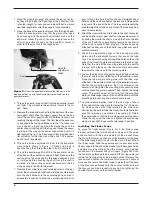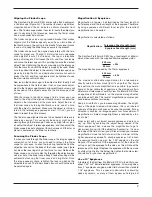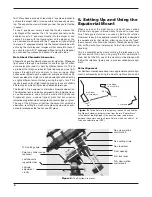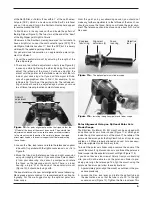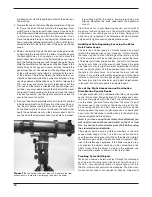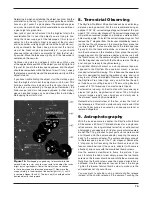
16
camera can vibrate the system and blur the resulting photo-
graphic image.
Moon Photography
This is perhaps the simplest form of astrophotography, as no
motor drive is required. Point the telescope toward the Moon,
and center it within the camera’s viewfinder. Focus the image
with the telescope’s focuser. Try several exposure times, all
less than 1 second, depending on the phase of the moon and
the ISO (film speed) of the film being used. A remote shutter
release is recommended, as touching the camera’s shutter
release can vibrate the camera enough to ruin the exposure.
Planetary Photography
Once basic Moon photography has been mastered, it’s time
to get images of the planets. This type of astrophotography
also works to get highly magnified shots of the Moon. In addi-
tion to the T-ring, you will need an optional Universal 1.25"
Camera Adapter. The TrueTrack Motor Drive System (single
or dual-axis) is also required. This is because a longer expo-
sure is necessary, which would cause the image to blur if no
motor drive was used for tracking. The equatorial mount must
be accurately polar aligned, too.
As before, connect the T-ring to your camera. Before connect-
ing the universal camera adapter to the T-ring, an eyepiece
must be inserted and locked into the body of the universal
camera adapter. Start by using a medium-low power eyepiece
(about 25mm); you can increase the magnification later with a
high-power eyepiece. Then connect the entire camera adapt-
er, with eyepiece inside, to the T-ring. Insert the whole system
into the focuser (with the camera adapter that comes with the
telescope attached to the drawtube) and secure firmly with
the thumb screws.
Aim the telescope at the planet (or Moon) you wish to shoot.
The image will be highly magnified, so you may need to use
the finder scope to center it within the camera’s viewfinder.
Turn the motor drive on. Adjust the telescope’s focuser so
that the image appears sharp in the camera’s viewfinder. The
camera’s shutter is now ready to be opened. A remote shut-
ter release must be used or the image will be blurred beyond
recognition. Try exposure times between 1 and 10 seconds,
depending upon the brightness of the planet to be photo-
graphed and the ISO of the film being used.
“Piggyback Photography”
The Moon and planets are interesting targets for the bud-
ding astrophotographer, but what next? Literally thousands of
deep-sky objects can be captured on film with a type of astro-
photography called “piggybacking”. The basic idea is that the
camera with its own camera lens attached rides on top of the
main telescope. The telescope and camera both move with
the rotation of the Earth when the mount is polar aligned and
the motor drive is engaged. This allows for a long exposure
through the camera without having the object or background
stars blurred. In addition to the motor drive (dual-axis), an
illuminated reticle eyepiece is also needed. The T-ring and
camera adapter are not needed, since the camera is expos-
ing through its own lens. Any camera lens with a focal length
between 35mm and 400mm is appropriate.
On the top of one of the tube rings is a piggyback camera
adapter. This is the black knob with the threaded shaft pro-
truding through it. The tube ring with the piggyback adapter
should be closest to the front end of the telescope tube.
Remove the tube rings from the equatorial mount and swap
their position if necessary. Now, connect the camera to the
piggyback adapter. There should be a 1/4"-20 mounting hole
in the bottom of the camera’s body. Thread the protruding
shaft of the piggyback adapter into the 1/4"-20 mounting hole
in the camera a few turns. Position the camera so it is paral-
lel with the telescope tube and turn the knurled black knob of
the piggyback adapter counter-clockwise until the camera is
locked into position.
Aim the telescope at a deep-sky object. It should be a fairly
large deep-sky object, as the camera lens will likely have a
wide field of view. Check to make sure that the object is also
centered in the camera’s viewfinder. Turn the motor drive on.
Now, look into the telescope’s eyepiece and center the bright-
est star within the field of view. Remove the eyepiece and
insert the illuminated reticle eyepiece into the focuser draw-
tube. Turn the eyepiece’s illuminator on (dimly!). Recenter
the bright star (guide star) on the crosshairs of the reticle
eyepiece. Check again to make sure that the object to be pho-
tographed is still centered within the camera’s field of view. If
it is not, recenter it by repositioning the camera on the piggy-
back adapter, or by moving the main telescope. If you move
the main telescope, then you will need to recenter another
guide star on the illuminated eyepiece’s crosshairs. Once the
object is centered in the camera and a guide star is centered
in the reticle eyepiece, you’re ready to shoot.
Deep-sky objects are quite faint, and typically require expo-
sures on the order of 10 minutes. To hold the camera’s shutter
open this long, you will need a locking shutter release cable.
Set the camera’s shutter to the “B” (bulb) setting. Depress the
locking shutter release cable and lock it. You are now expos-
ing your first deep-sky object.
While exposing through the camera lens, you will need to
monitor the accuracy of the mount’s tracking by looking
through the illuminated reticle eyepiece in the main telescope.
If the guide star drifts from its initial position, then use the
hand controller of the motor drive to “move” the guide star
back to the center of the crosshairs. Any drifting along the
Dec. axis is a result of improper polar alignment, so if the
guide star drifts greatly in Dec., the mount may need to be
polar aligned more accurately.
When the exposure is complete, unlock the shutter release
cable and close the camera’s shutter.
Astrophotography can be enjoyable and rewarding, as well
as frustrating and time-consuming. Start slowly and consult
outside resources, such as books and magazines, for more
details about astrophotography. Remember….have fun!



